The couple behind Bluebird Canyon Farms shares the story of their journey toward sustainability.
By Sharael Kolberg | Photos by Jody Tiongco
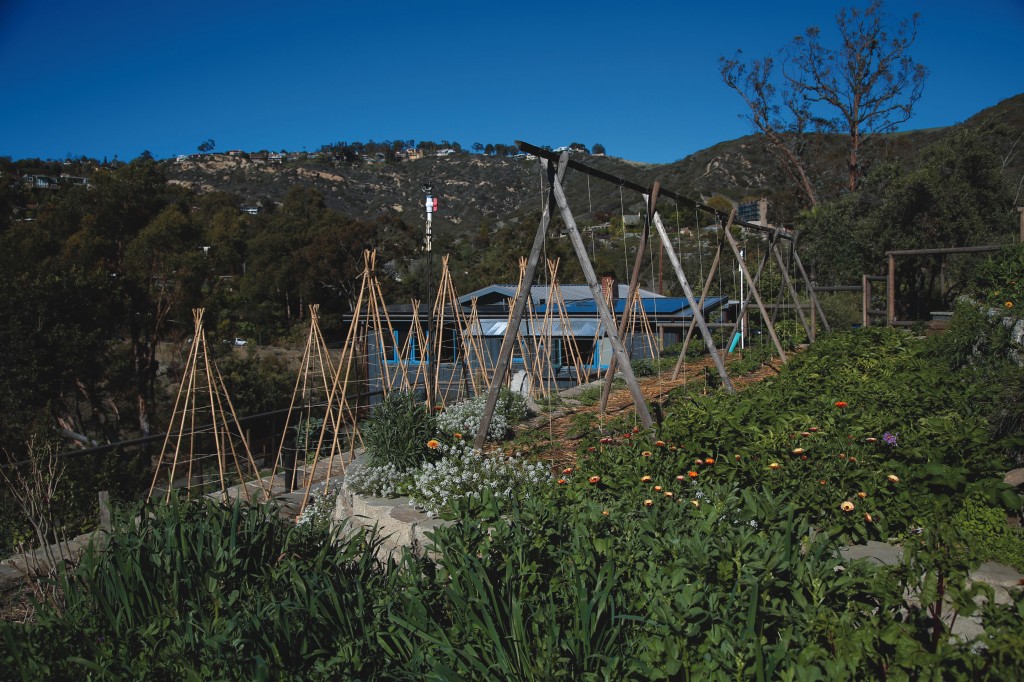
When Scott Tenney and his wife, Mariella Simon, purchased a 15-acre plot of land in 2010 in the Bluebird Canyon neighborhood of Laguna Beach, their vision for a certified organic, biodynamic urban farm started to become a reality. Over the past four years, Bluebird Canyon Farms has grown from an overgrown and neglected plot of land into a thriving experimental growth site that also serves as a research center to learn more about hybridizing seeds, fertilizers, crops and tools.
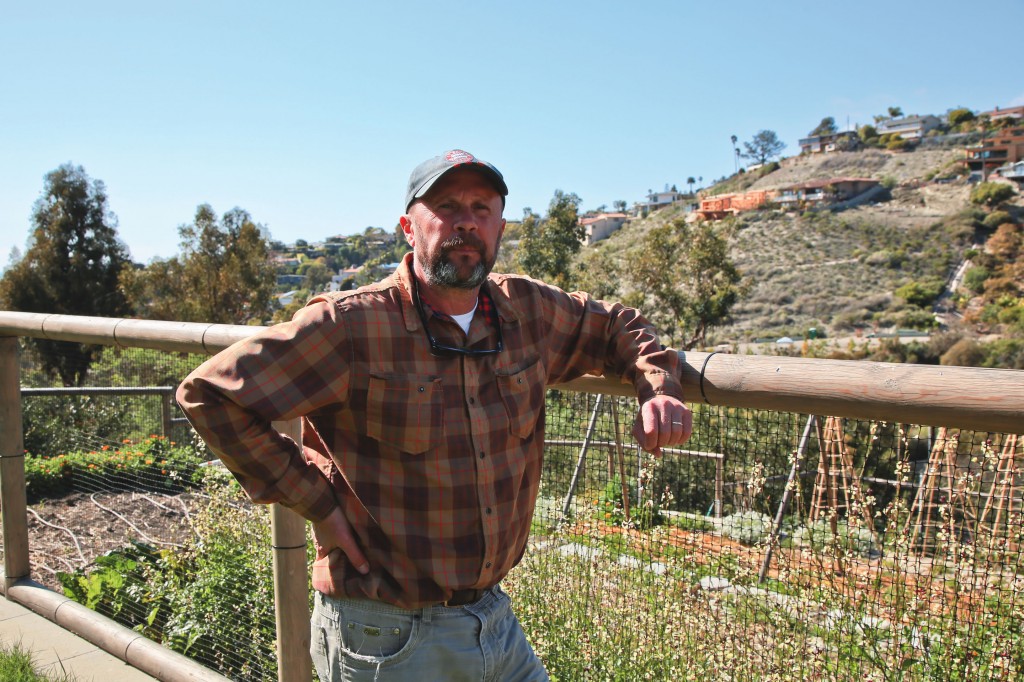
“It has always been our intent to honor the land and use the property to inform and inspire others by offering hands-on opportunities to learn, plan, develop, operate and sustain community-scale urban agriculture projects,” Scott says. “Our philosophy is to share the experience and knowledge of our associates, allowing others to learn by doing.”
A Communal Effort
Scott, Mariella and about eight associates have been working tirelessly to turn the property into a research site and educational meeting place where experts can gather to share ideas, perform interactive demonstrations and provide in-depth knowledge on a variety of subjects related to urban agriculture. In the meantime, the couple has welcomed interns and apprentices to gain hands-on experience on a working farm.
One of the associates who has been helping to restore the farm is 23-year-old Connor Dorais. With a degree in environmental science from the University of Redlands and interests in resource conservation and sustainable agriculture, he felt that this was a project he had to get involved in.
“Being a part of something new and having your foot in the door—before the door is fully finished—is a neat idea,” he says of his decision to join the couple in developing the farm. “It’s great to see things from the beginning and be able to give input. I’m passionate about urban agriculture and enjoy helping to bring food closer to the community.” Connor lives on the property and says his typical duties change daily, but some of his responsibilities have included restoring plants and applying organic fertilizers, re-clipping chickens’ wings, checking on the farm’s resident honeybees, assisting with maintenance work and keeping the property clean for visitors.
Connor is just one of several associates who have contributed to the renovation of the property. In fact, when the pair originally purchased the land, they worked with several organizations and individuals to come up with a master plan.
“Our biggest challenge [involved] the constraints of the site because of how badly the site was damaged,” Scott says, adding that the farm has spearheaded an ongoing ecological restoration project to repair the erosion-damaged hillsides. The initiative will also restore the weakened population of California sage scrub impacted by the introductions of invasive, non-native plant species prior to 2010.
Along with Mariella, he worked with experts from the U.S. Department of Agriculture, San Juan Capistrano’s Tree of Life Nursery and the University of California, Davis to improve the health of the terrain, create habitats for native animals and increase the site’s overall productivity. “My wife and I are very passionate about regenerative landscaping and restoration ecology,” he says. “We find it very gratifying to have converted this property from a broken-down condition into a healthy and thriving site.”
Flora and Fauna
The farm now blossoms with a variety of organic produce, heirloom hens and hybridized bees. With an apiary that houses nine beehives, Scott wanted to create a stable location where a population of bees could be kept to act as a breeding colony because he believes that colony collapse could be caused by poor genetic diversity.
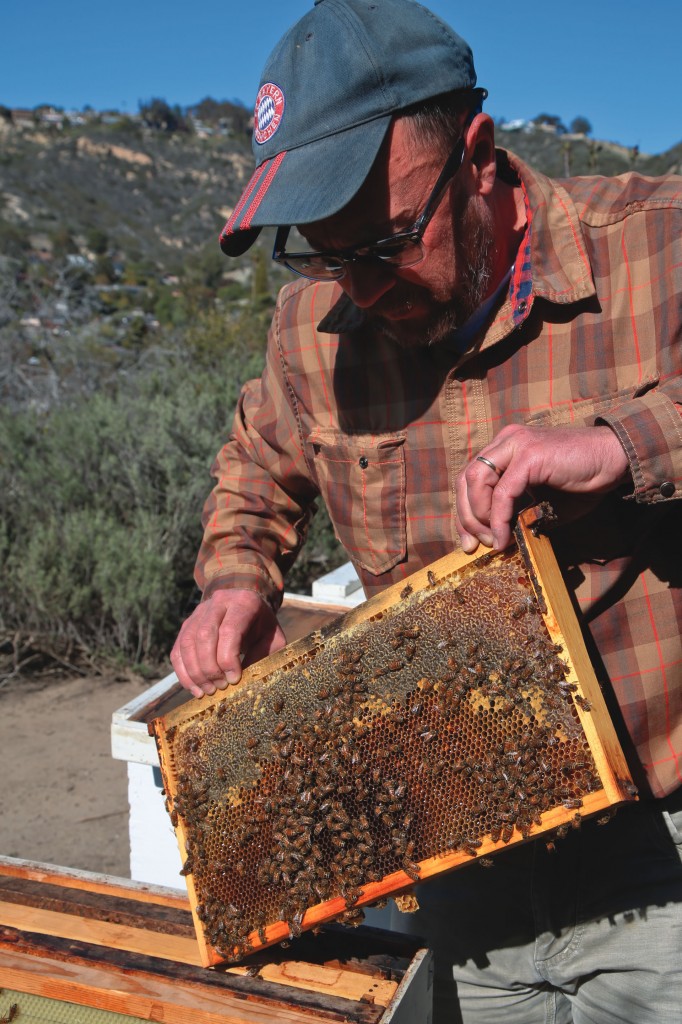
“We want to develop a local Laguna honeybee hybrid that is a cross between wild local bees and domestic honeybees,” he explains. “Honeybees are threatened, and local bees are a great source of genetic diversity. We reason that by hybridizing a local bee, we can produce a honeybee with many of the qualities of domestic bees but one who thrives like the wild bees in our region. Wild bees are hardier and cleaner, and are more disease-resistant in the hive.” In the future, Scott plans to seek permission from the city to expand the apiary to fit 10 or more hives.
In addition to the raw honey they harvest from the beehives, Scott and Mariella also enjoy fresh eggs from their 17 hens. And, in true Bluebird Canyon Farms’ style, these are not just ordinary backyard chickens—they’re heirloom black copper marans, one of the rarest breeds in the U.S. “We chose to support genetic conservation of heritage breeds,” Scott says. The black-and-white hens lay dark brown eggs with creamy yolks that are highly sought-after by gourmet chefs.
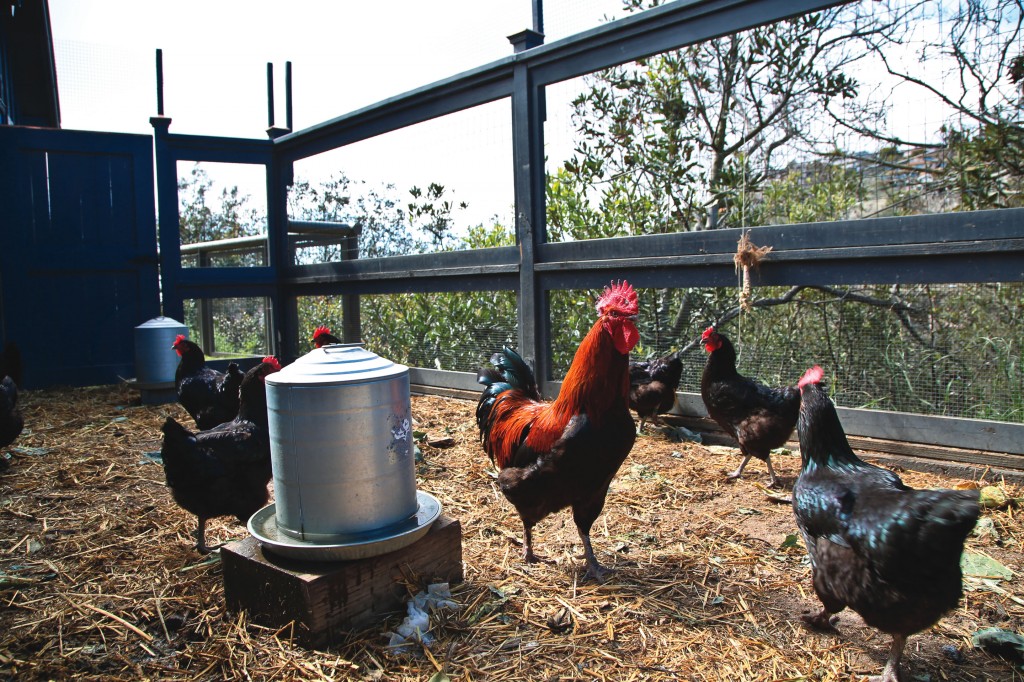
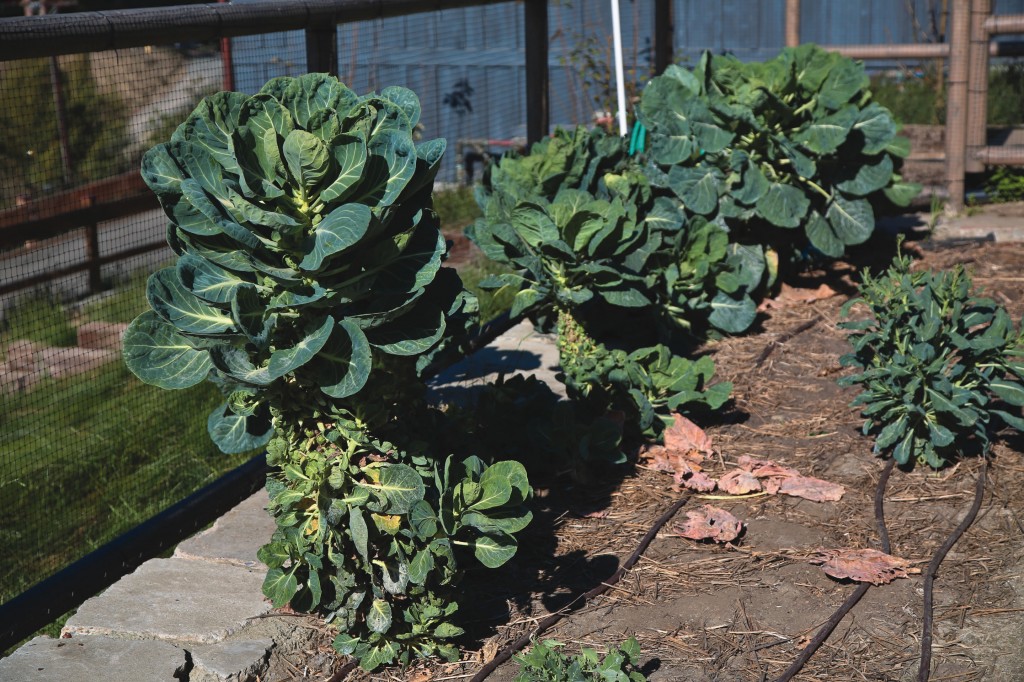
In an effort to make the hens more tranquil and establish order in the flock, the couple also keeps one rooster. To shield their neighbors from its early morning crow, the two keep the rooster inside the chicken coop until nearly 9 a.m. The chickens are free to roam the coyote-proof enclosure during the day and bed down in the safety of their custom-made coop—which also features double-paned windows—at night. Raising chickens on the farm is not all about the eggs; Scott says it’s also a way to demonstrate the technique for those who want to try it in their own backyards.
The produce grown on the farm is just as impressive. According to Scott, they cultivate crops across 3 acres including a nearly 1-acre garden where heirloom seasonal produce is grown using a proprietary compost-based, biodynamic fertilizer. The additional acres operate under a rotating cover crop regimen to further improve the soil. “We strive to demonstrate how to grow and nurture healthy soil ecosystems that support sustainable agricultural practices,” Scott says.
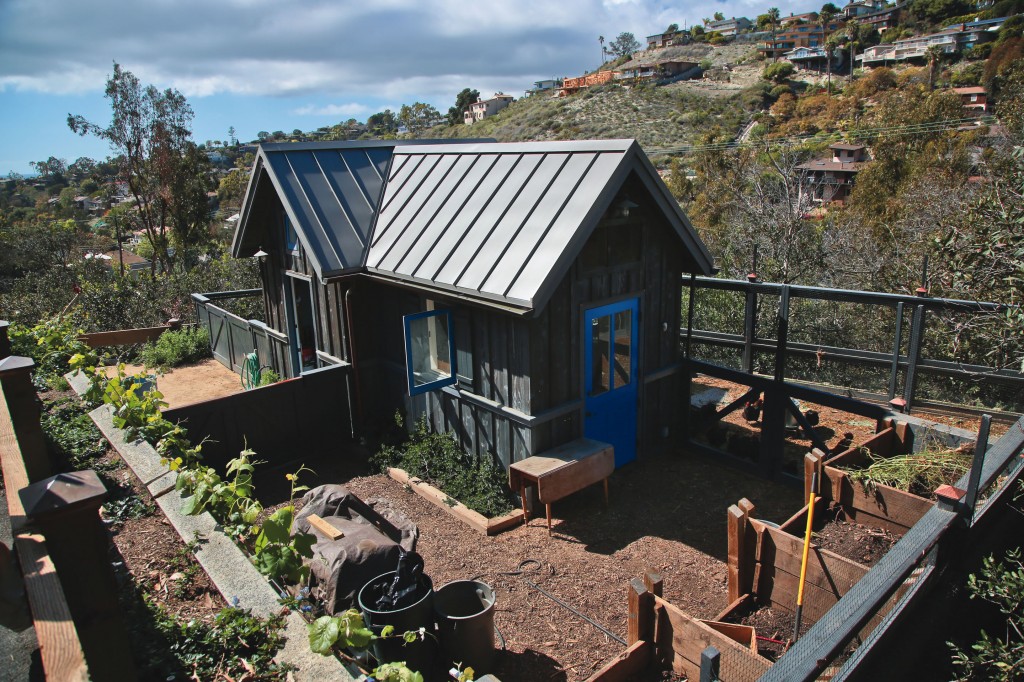
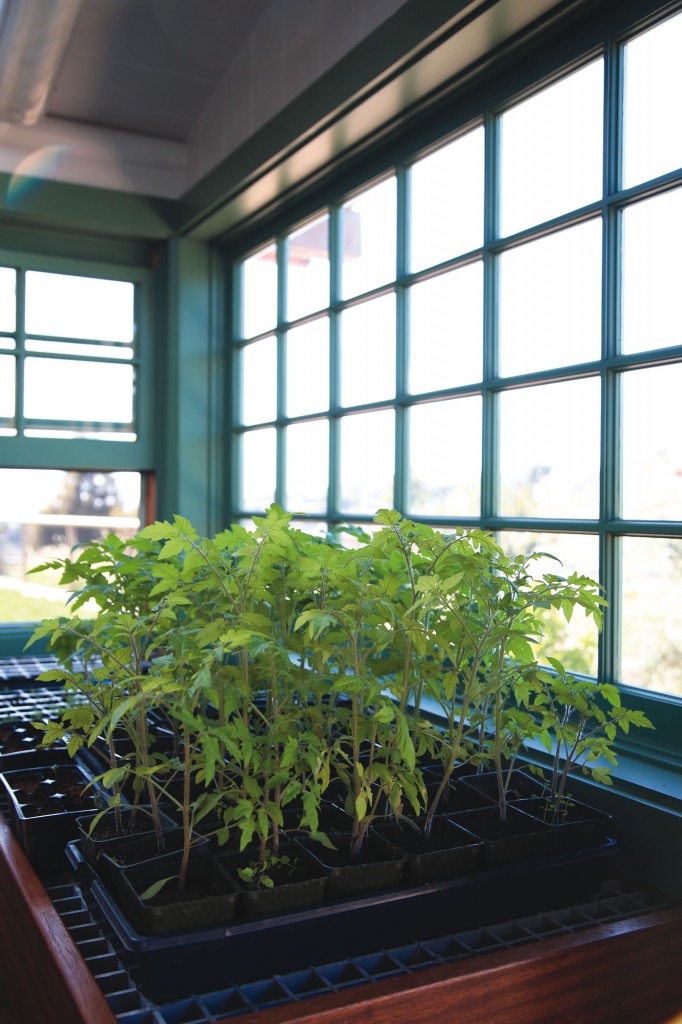
Depending on the time of year, you’ll find raspberries, strawberries, asparagus, kale, broccoli, tomatoes, lettuce or cover crops of fava beans or oats that are tilled back into the soil to maintain its fertility. The garden’s terraced walls were made from recycled concrete that came from a demolition project in Lake Forest, and the space even includes an outdoor kitchen complete with a pizza oven and barbecue.
Ecologically Minded
Much forethought goes into designing the practices that are put into place on the land, which include composting, gray water irrigation, rainwater harvesting and green construction. “We seek to influence the ‘farm of the future’ by helping to reduce energy intensiveness of current agricultural practices in this post-peak oil economy,” Scott says. “And we hope that through our efforts, we will encourage others to fiercely protect and steward the land and natural resources entrusted to them.”
The farm includes a large-scale composting and vermi-composting area, where the couple recycles scraps from the garden, eggshells and shredded paper. Once the compost has undergone the decomposition process, it’s returned back to the garden to nourish the plants and soil.
In terms of sustainable irrigation, the number of sophisticated water and energy conservation features built into the site includes systems to harvest water and manage rainwater runoff. The farm’s water sink allows recycled water to run into the brush and orchard. A 3,000-gallon cistern on the property, meanwhile, catches rainwater that can be used to irrigate the plants and trees.
The effort to protect and preserve also extends to the historic architecture that came with the property. When the twosome took over the land, it was home to six dilapidated structures in dire need of repair. Rather than tear down the buildings, the pair decided to keep the original framework and use reclaimed lumber to renovate the buildings and turn them into an apiary, workshop, bungalow, greenhouse, “flower chateau” and the Bluebird Canyon Lodge, the property’s main structure.
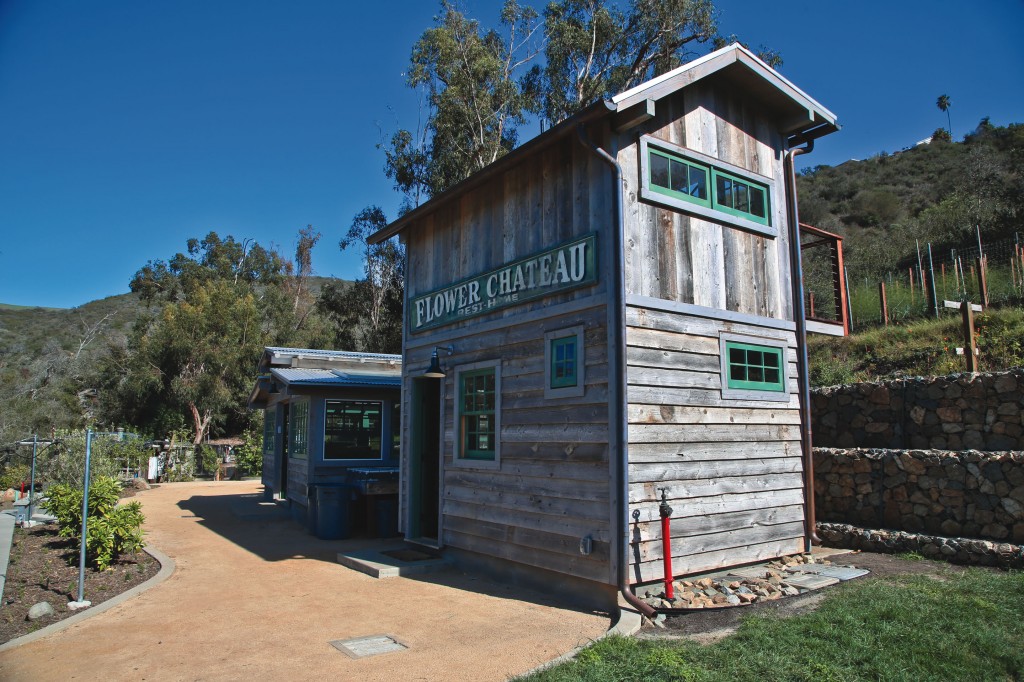
“This is old California, specifically old Laguna, which is quickly disappearing in front of our eyes,” Mariella explains. “It was important to our team that the site look and feel Californian, especially like old Laguna. We wanted people to have an experience when they come to the site that it is unique to the history of the area.” Today, the two-bedroom Bluebird Canyon Lodge reflects her Bavarian heritage with spruce floors, cedar walls and a quartz fireplace and bar that give it a distinctly rustic feel.
The lodge was used as the site of Transition Laguna Beach’s annual Harvest Celebration last year. Likewise, the twosome welcomes the opportunity to be a community resource for guests. With permission from the city, the husband and wife team envisions operating a system in which up to a dozen neighbors could pay or barter for a weekly basket of fresh produce grown on the farm.
Additionally, they hope to run a weekly or biweekly product exchange, which will offer neighbors an opportunity to come to the farm and exchange something of value for produce or other items made on the farm, such as furnishings created from repurposed materials; biodynamic horticultural supplements used to recondition soil, nourish plants and control pests; or fresh eggs and honey. “Philosophically, we are keenly interested in the ‘world made by hand’ concept,” Mariella says.
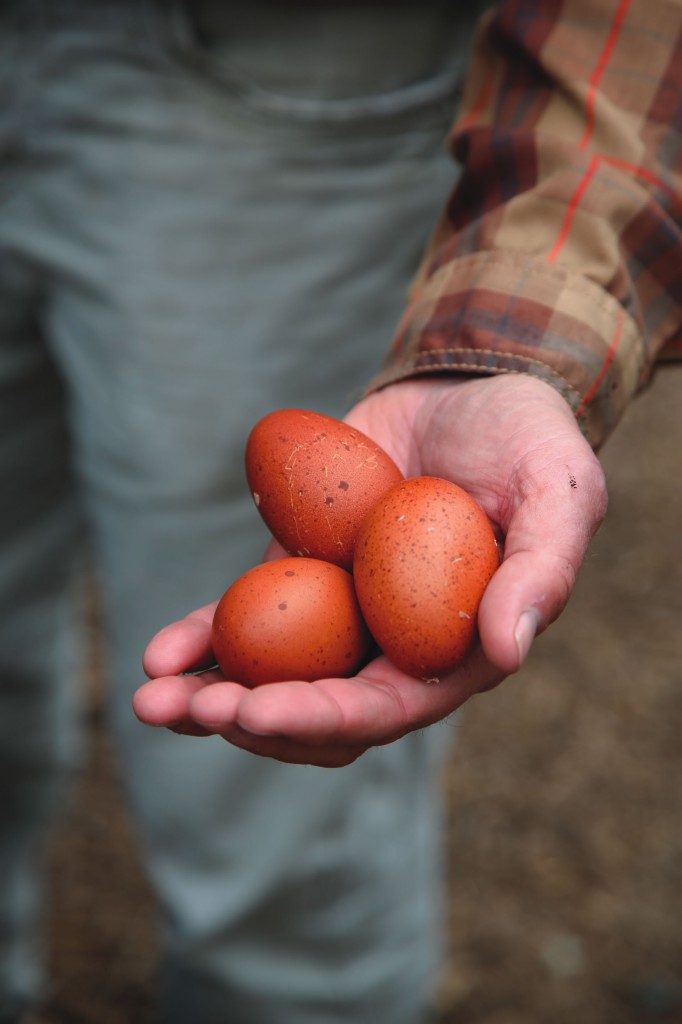
In the not-too-distant future, Scott and Mariella hope to be able to work with the city to host more community events and hands-on workshops. If their hopes for Bluebird Canyon Farms are realized, Laguna might just become a leader in urban agriculture and an inspiration to other cities looking to become more self-sufficient and less dependent on the fossil fuels needed to import water, food and energy. LBM
Green Machines
In 2012, the Bluebird Canyon Farms team designed and built a prototype of a solar-powered hydroponic system, nicknamed the “Green Machine.” Hydroponics is a horticultural technique that uses mineral nutrient solutions to grow plants in water, without the use of soil. Typically, this type of system would require electrical power to pump the water, but the prototype was built with an environmentally friendly solar-powered pump. Using tanks, pumps, timers, tubing and an air mover, the Green Machine was able to grow approximately 200 plants in a 20- by 10-foot space.
“It was developed as a standardized, food production unit in a ‘box,’ ” says Scott Tenney, owner of Bluebird Canyon Farms. Our inspiration was to build something that could be deployed to an urban area such as Detroit, which has seen better days and struggles with food security and supply issues.”
Always looking to improve, the team is currently developing a larger, commercial-sized unit called “Farm of the Future” that incorporates a forward-thinking food system called aquaponics (a technique that uses aquatic animals such as snails, fish, crayfish or prawns in tanks to feed plant life). Additionally, aquaponics allows more produce to be grown than conventional methods, and very well could become the means by which we get our fruits and vegetables in the future.




